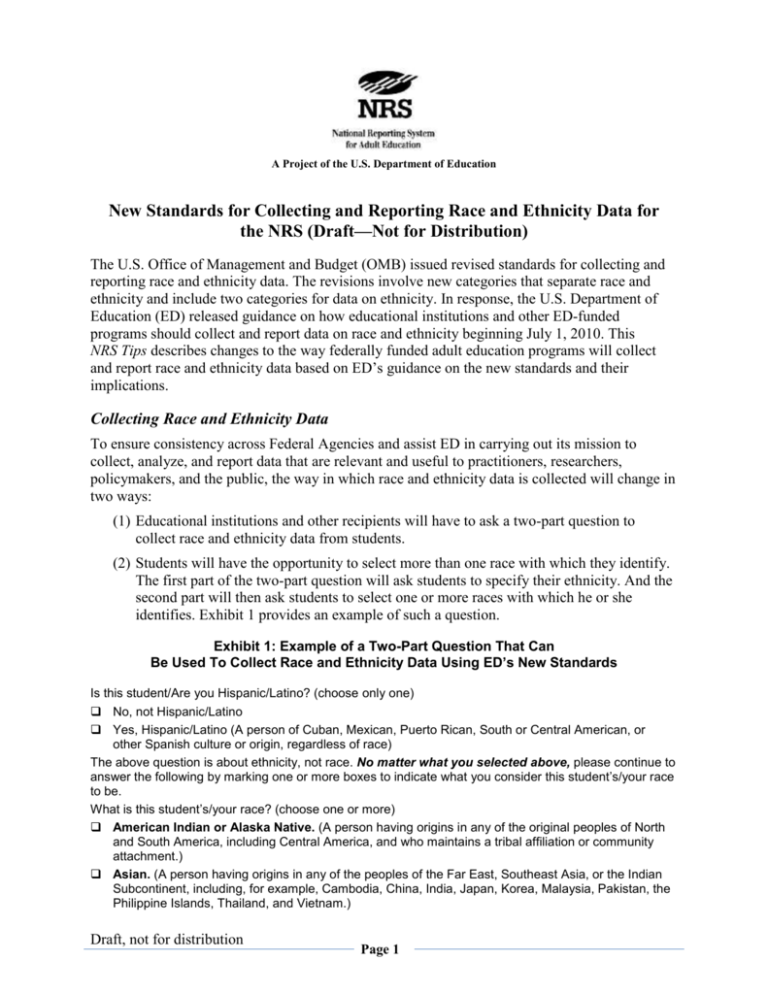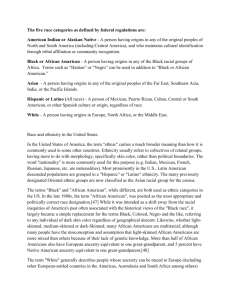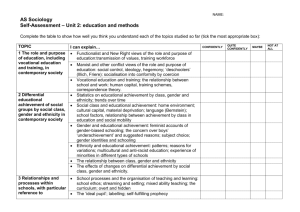New Standards for Collecting and Reporting Race and Ethnicity
advertisement

A Project of the U.S. Department of Education New Standards for Collecting and Reporting Race and Ethnicity Data for the NRS (Draft—Not for Distribution) The U.S. Office of Management and Budget (OMB) issued revised standards for collecting and reporting race and ethnicity data. The revisions involve new categories that separate race and ethnicity and include two categories for data on ethnicity. In response, the U.S. Department of Education (ED) released guidance on how educational institutions and other ED-funded programs should collect and report data on race and ethnicity beginning July 1, 2010. This NRS Tips describes changes to the way federally funded adult education programs will collect and report race and ethnicity data based on ED’s guidance on the new standards and their implications. Collecting Race and Ethnicity Data To ensure consistency across Federal Agencies and assist ED in carrying out its mission to collect, analyze, and report data that are relevant and useful to practitioners, researchers, policymakers, and the public, the way in which race and ethnicity data is collected will change in two ways: (1) Educational institutions and other recipients will have to ask a two-part question to collect race and ethnicity data from students. (2) Students will have the opportunity to select more than one race with which they identify. The first part of the two-part question will ask students to specify their ethnicity. And the second part will then ask students to select one or more races with which he or she identifies. Exhibit 1 provides an example of such a question. Exhibit 1: Example of a Two-Part Question That Can Be Used To Collect Race and Ethnicity Data Using ED’s New Standards Is this student/Are you Hispanic/Latino? (choose only one) No, not Hispanic/Latino Yes, Hispanic/Latino (A person of Cuban, Mexican, Puerto Rican, South or Central American, or other Spanish culture or origin, regardless of race) The above question is about ethnicity, not race. No matter what you selected above, please continue to answer the following by marking one or more boxes to indicate what you consider this student’s/your race to be. What is this student’s/your race? (choose one or more) American Indian or Alaska Native. (A person having origins in any of the original peoples of North and South America, including Central America, and who maintains a tribal affiliation or community attachment.) Asian. (A person having origins in any of the peoples of the Far East, Southeast Asia, or the Indian Subcontinent, including, for example, Cambodia, China, India, Japan, Korea, Malaysia, Pakistan, the Philippine Islands, Thailand, and Vietnam.) Draft, not for distribution Page 1 Black or African American. (A person having origins in any of the Black racial groups of Africa.) Native Hawaiian or Other Pacific Islander. (A person having origins in any of the original peoples of Hawaii, Guam, Samoa, or other Pacific Islands.) White. (A person having origins in any of the original peoples of Europe, the Middle East, or North Africa.) ED does not require reporting of the races in the Hispanic/Latino population, but the two-part question format is still required. ED requires programs to keep the original individual responses to the two-part question to allow access to this information when needed. Reporting Race and Ethnicity Data The new standards for reporting race and ethnicity data involve two sets of changes: (1) Separate reporting of Hispanic/Latino ethnicity and race. (2) Revisions to the current definitions of racial and ethnic categories, including a new “two or more races” reporting category. Separating race and ethnicity The new requirements create a clear separation of race and Hispanic/Latino ethnicity. Students must first self-identify as Hispanic/Latino or not Hispanic/Latino, regardless of their racial background. Students selecting Hispanic/Latino will only be reported to ED as “Hispanic/Latino of any race.” Only students who do not self-identify as Hispanic/Latino ethnicity will be in other racial categories for Federal reporting. A student can be counted in only one category. A new reporting category and revised definitions for race and ethnicity ED will be using a new category for reporting race and ethnicity data: “two or more races” for students self-identifying as belonging to multiple races. The following four examples from ED’s guidance demonstrate how programs will report using the new standards in light of the additional category: Example 1: A student self-identifies as Hispanic/Latino and as Asian. This student is reported only in the Hispanic/Latino category. Example 2: A student self-identifies as Hispanic/Latino and as Asian and Black or African American. This student is reported only in the Hispanic/Latino category. Example 3: A student self-identifies as non-Hispanic/Latino and as Native Hawaiian or Other Pacific Islander. This student is reported in the Native Hawaiian or Other Pacific Islander category. Example 4: A student self-identifies as non-Hispanic/Latino and as American Indian or Alaska Native and White. This student is reported in the two or more races category. Definitions for a number of reporting categories also have been revised; notably, categories of race no longer make reference to the hispanicity of a student. Additional regions or countries of origin also were added, and a student having origins in the Philippines will no longer be reported in the “Native Hawaiian and Pacific Islander” category. Instead, he or she should be reported as “Asian.” Exhibit 2 shows a comparison of the existing and new reporting categories and their definitions, with differences underlined to facilitate your review. Draft, not for distribution Page 2 Exhibit 2: Comparison of Definitions for Race and Ethnicity Reporting Categories Definitions of Existing Reporting Categories American Indian or Alaskan Native—A person who has origins in any of the original peoples of North America and who maintains cultural identification through tribal affiliation or community recognition. Asian—A person who has origins in any of the original peoples of the Far East, Southeast Asia, or the Indian subcontinent (e.g., China, India, Japan, and Korea). Native Hawaiian or Other Pacific Islander—A person who has origins as a native of the Hawaiian Islands or the other islands of the Pacific, such as the Philippine Islands and Samoa. Black or African-American—A person who has origins in any of the Black racial groups of Africa but not of Hispanic culture or origin. Hispanic or Latino—A person of Mexican, Puerto Rican, Cuban, Central or South American, or other Spanish culture or origin, regardless of race. White—A person who has origins in any of the original peoples of Europe, North Africa, or the Middle East but not of Hispanic culture or origin. Definitions of Reporting Categories Using ED’s New Standards (To Be Implemented Beginning July 1, 2010) American Indian or Alaska Native—A person having origins in any of the original peoples of North and South America (including Central America), and who maintains a tribal affiliation or community attachment. Asian—A person having origins in any of the original peoples of the Far East, Southeast Asia, or the Indian subcontinent, including, for example, Cambodia, China, India, Japan, Korea, Malaysia, Pakistan, the Philippine Islands, Thailand, and Vietnam. Native Hawaiian or Other Pacific Islander—A person having origins in any of the original peoples of Hawaii, Guam, Samoa, or other Pacific Islands. Black or African American—A person having origins in any of the Black racial groups of Africa. Hispanic/Latino of any race—A person of Cuban, Mexican, Puerto Rican, South or Central American, or other Spanish culture or origin, regardless of race. The term ``Spanish origin'' can be used in addition to ``Hispanic/Latino or Latino.'' White—A person having origins in any of the original peoples of Europe, the Middle East, or North Africa. Two or more races—A person having origins in two or more race categories and not Hispanic/Latino. Implications of New Standards To meet ED’s requirement to implement the new standards for collecting and reporting race and ethnicity data starting July 1, 2010, State adult education programs can take a number of steps. Four of the most critical steps are described below. Examine current policies and procedures governing how your State collects and reports race and ethnicity data to determine what will need to be updated. States may need to set a new coding scheme if nonfederal policies dictate that a State must collect additional information about its students’ ethnicity. Although not required, States may wish to bridge between the existing and new reporting categories to allow time for trend analysis using those data. Consider what adjustments will be required for your State’s student intake forms and software systems that collect, maintain, and report race and ethnicity data. The State data system must be capable of separating race and ethnicity and aggregating additional race and ethnicity categories used within the State into the Federal reporting categories. Students are to be reported in only one of the Federal categories, according to the procedures just described. Consequently, you may need to make adjustments in your State’s intake forms and database, which may include performing a data conversion that may require re-identifying students, changing data entry screens, changing business rules to allow proper data validation, and updating the logic that generates your reports with race and ethnicity data based on the new business rules. As your State makes these changes, consider how they may affect your other reporting obligations to other State agencies or programs and/or other Draft, not for distribution Page 3 funders. Finally, it also will be necessary to develop a plan to test whether the changes are accurate. For States that use vendors, it is important that they understand the changes based on the new standards and can set a reasonable schedule to complete the changes. Describe the changes and their implications to key constituents. Training for staff at every level of the State program will be critical to the successful implementation of the new standards. Training should be customized depending on the role staff have and include a description of the new standards, how you are implementing them, and what the impact will be for their work. Adjust how you report to the National Reporting System for Adult Education (NRS). Tables 1, 2, and 12 of the NRS have been revised to reflect the new race and ethnicity categories, and these revised tables are required for the program year beginning on July 1, 2010, for the report due to ED on December 31, 2011. Additional Resources If you would like more information, including guidance on additional race and ethnicity categories, please consult the following documents. Managing an Identity Crisis: Forum Guide to Implementing New Federal Race and Ethnicity Categories is a helpful guide developed by the National Forum on Education Statistics’ Race/Ethnicity Data Implementation Task Force for State and local education agencies that outlines best practices for implementing the new standards. (http://nces.ed.gov/pubsearch/pubsinfo.asp?pubid=2008802) Revisions to the Standards for the Classification of Federal Data on Race and Ethnicity, Notice of Decision is the original document issued by OMB describing the new standards to collect, maintain, and report race and ethnicity data for Federal Agencies. It appeared in the Federal Register on October 30, 1997. (http://www.whitehouse.gov/omb/fedreg_1997standards) Final Guidance on Maintaining, Collecting, and Reporting Racial and Ethnic Data to the U.S. Department of Education, Final Guidance provides instructions on how educational institutions and other ED-funded programs must manage race and ethnicity data. It appeared in the Federal Register on October 19, 2007. (http://edocket.access.gpo.gov/2007/pdf/E7-20613.pdf) The National Reporting System (NRS) is the accountability system for the federally funded, State-administered adult education program. It addresses the accountability requirements of the Adult Education and Family Literacy Act, Title II of the Workforce Investment Act (WIA-P.L. 105–220). NRS Tips is a quick reference tool for State staff, program directors, and adult education teachers. NRS Tips documents are written and produced by the staff at the American Institutes for Research® (AIR®), a nonprofit research and policy organization (see http://www.air.org), under contract with the Division of Adult Educational and Literacy (DAEL) of the U.S. Department of Education. Visit http://www.nrsweb.org for further information. Do you have an idea for NRS Tips? Send it to nrs@air.org. Draft, not for distribution Page 4









